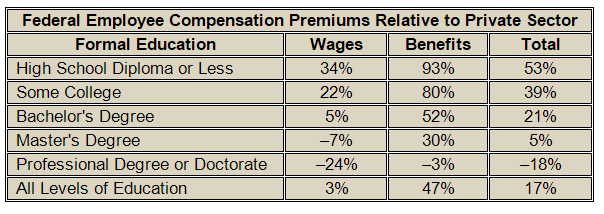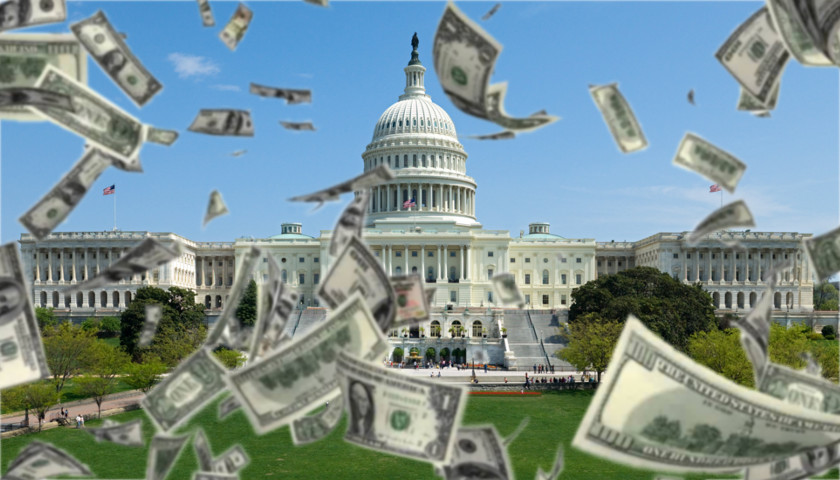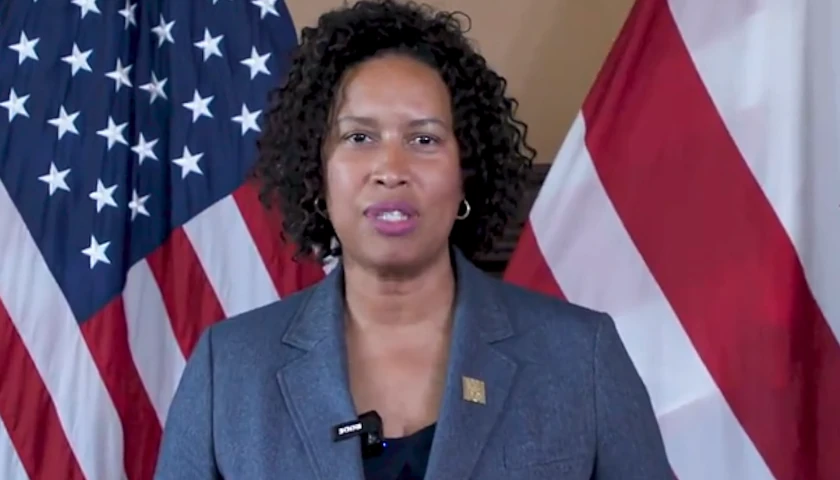Compensation for federal, state, and local government employees cost U.S. taxpayers $1.9 trillion in 2016. This amounts to an average of $15,176 from every household in the United States. President Trump recently moved to rein in some of these costs by canceling pay raises for federal civilian employees, who received $331 billion in compensation during 2017.
Some politicians and an association of federal employees have criticized Trump for this action, saying that federal workers are underpaid and deserve a raise. However, a broad range of studies have found that most federal civilian employees are paid better than comparable workers in the private-sector.
Trump’s Action and Criticism of It
When private-sector incomes rise, federal law generally requires across-the-board pay raises for most federal civilian employees. The law gives added raises to federal workers in certain localities if their compensation is lower than private-sector workers in those areas. The law also allows the president of the U.S. to overrule these raises, and President Trump recently did so, writing:
We must maintain efforts to put our nation on a fiscally sustainable course, and federal agency budgets cannot sustain such increases. … Specifically, I have determined that for 2019, both across the board pay increases and locality pay increases will be set at zero. These alternative pay plan decisions will not materially affect our ability to attract and retain a well qualified federal workforce.
Before Trump announced this, the National Active and Retired Federal Employees Association asserted that “this pay raise is important to keep federal pay from falling even farther behind that of the private sector.” After the announcement, Republican politicians in areas with large populations of federal employees criticized Trump:
- Congresswoman Barbara Comstock of Virginia wrote, “Our public servants have been getting shortchanged for years; including three years of pay freezes under the Obama administration.”
- Corey Stewart, who is running for the U.S. Senate in Virginia, said, “I almost never differ with President Trump, but in this case I do … These workers need and deserve a pay raise.”
Federal Worker Compensation
Contrary to those claims, a 2017 Congressional Budget Office study compared the compensation of full-time, year-round private sector workers to non-postal, civilian, federal workers in 2011 to 2015. It accounted for education, occupation, work experience, geographic location, employer size, and various demographic characteristics.  The study found that:
The study found that:
- federal workers received an average of 17% more total compensation than comparable private sector workers.
- across various education levels, federal employee compensation premiums ranged from a low of –18% for workers with a professional degree or doctorate to a high of 53% for workers with a high school diploma or less
The study did not account for “many characteristics that are not easy to observe or measure,” such as workers’ “natural ability, personal motivation, and effort.” Just Facts is unaware of comprehensive data that quantifies such attributes, but a scientific surveyconducted in 2001 found that:
- “59 percent of federal workers say securing a paycheck was more important than doing something worthwhile.”
- “65 percent say job security was more important than helping the public.”
- “only 30 percent believe their organization does a very or somewhat good job of disciplining poor performers.”
The incentives for government employees to perform well are often mitigated by their pay systems. Per the Congressional Budget Office: “For most federal employees, salaries or wages are determined by their rank in a pay schedule,” and “most federal workers compensated under pay schedules move to progressively higher grades as they are eligible. That system ensures that employees in the same type of job who have similar tenure receive similar pay, but it limits managers’ flexibility to reward workers who perform well or to constrain the salaries of workers who perform poorly.”
A 2010 study by the U.S. Bureau of Labor Statistics found that full-time private industry workers worked an average of 12% more hours per year than full-time state and local government workers. This includes time spent working beyond assigned schedules at the workplace and at home.
In keeping with such realities and the principle of rewarding people for the quality and quantity of their work, Trump also wrote:
Federal employee pay must be performance-based, and aligned strategically toward recruiting, retaining, and rewarding high-performing federal employees and those with critical skill sets. Across-the-board pay increases and locality pay increases, in particular, have long-term fixed costs, yet fail to address existing pay disparities or target mission critical recruitment and retention goals.
Other Analyses
In 2012, the U.S. Government Accountability Office published an examination of six studies identified through a “detailed literature review of academic journals” and other sources to find recent, original studies that “have the explicit and primary purpose of comparing federal and private sector pay and total compensation.” These included:
- an earlier version of the Congressional Budget Office study cited above.
- a study by the Project on Government Oversight, a watchdog group “that investigates and exposes waste, corruption, abuse of power, and when the government fails to serve the public or silences those who report wrongdoing.”
- three studies conducted by conservative/libertarian think tanks, including the Heritage Foundation, the American Enterprise Institute, and the Cato Institute.
- an analysis by President Obama’s Pay Agent, “the entity responsible for recommending federal locality pay adjustments to the president….”
All of the studies except for the one from Obama’s Pay Agent found that federal employees make more than private sector workers, with premiums ranging from 16% to 100%. The 100% figure came from the Cato study, which didn’t take into account worker attributes like education. Excluding that, the federal premiums from the various studies were 16%, 20%, 30–40%, and 61%.
In the same month this Government Accountability Office report was released, the Griswold Center for Economic Policy Studies at Princeton University published a working paper on the same topic. It was formally published a year later in the journal Public Administration Research. This study found that “taking differences in employee characteristics into account,” federal workers earn 34.2% more than private-sector workers. This figure doesn’t account for other benefits that are more generous in the public sector, like “employment security, paid vacation, health insurance benefits, and so on.”
Obama’s Pay Agent, on the other hand, found that federal workers make an average of 24% less than nonfederal workers (including state and local government employees). The Government Accountability Office identified two defining features of this study:
- It “did not include an analysis of benefits as part of total compensation.” This is a critical omission, because federal jobs typically have much better benefits than the private sector. The 2017 CBO study found that such benefits account for more than 80% of the compensation differential between federal and private workers.
- It compared workers with similar job descriptions “without taking account” of their “personal characteristics,” “such as education or job experience.” This methodology understates the relative pay of federal workers, because the federal government promotes workers at a faster rate than in the private sector. As explained by Ph.D. economist Melissa Famulari in a study about this issue, federal workers have “significantly fewer years of education and experience” and “are substantially less skilled than private sector workers in the same detailed occupation.” Per the above-cited Princeton study, comparing jobs instead of worker attributes is also “problematic because some occupations, such as sales, are almost all in the private sector, while other job categories are almost all public.”
In other words, Obama’s Pay Agent failed to account for workers’ benefits, education, experience, or skills. Thus, the study is effectively useless for comparing the total compensation of comparable employees.
Contrastingly, the Princeton study and all of the studies examined by the Government Accountability Office that take these factors into account found that federal employees enjoy a significant advantage in compensation. These studies have limitations and employ a “frequently misused” statistical technique called “multiple regression.” Thus, none are the end-all, but the combined weight of these diverse studies and surrounding facts leave little doubt that most federal employees are paid better than their private-sector counterparts.
– – –
James D. Agresti is the president of Just Facts, a think tank dedicated to publishing rigorously documented facts about public policy issues. He holds a Bachelor of Science in Mechanical Engineering from Brown University and has worked as a designer of jet engine components and systems, a technical sales professional, and chief engineer of a firm that customizes helicopters. He is also the author of Rational Conclusions, a meticulously researched and acclaimed book evidencing factual support for the Bible across a broad array of academic disciplines.






There are public employees with part time jobs here in Tennessee who get a PENSION! There are part time employees here in Tennessee who are on their employer’s health care plan. That doesn’t exist in private industry!!! WAAA!!!! I won’t hold my breath for those particular inequalities to be dealt with anytime soon, because these are perks of our Republican controlled Tennessee General Assembly. Fine for me but not for thee! I have worked in both the private and public sector, and don’t begrudge these folks a higher salary at all. If you want to possibly earn more, quit whining and take a position in government.